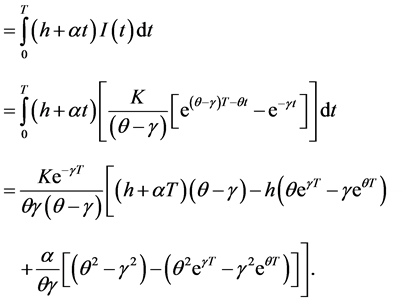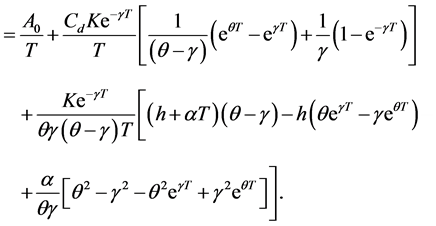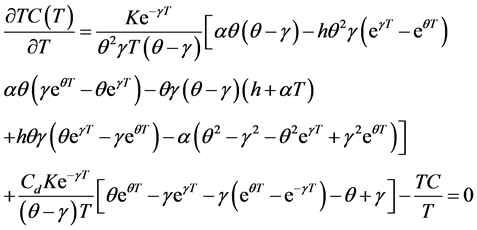An Inventory Model for Deteriorating Items with Exponential Declining Demand and Time-Varying Holding Cost ()
Keywords: Constant Deterioration; Exponential Declining Demand; Inventory; Time Dependent Holding Cost
1. Introduction
The main objective of the proposed model is to develop an inventory model for a deteriorating item having a time-dependent exponential declining demand rate and time-varying holding cost. The literature review of the present paper is discussed as follows:
Generally, deteriorating items refer to the items that become damaged, decayed, spoiled, lost of utility or lost of its marginal value, evaporative, devaluation, invalid, degradative and so on through time. The process of deterioration happens in two categories of items. The first category refers to the items that become damaged, spoiled, decayed, loss of utility, evaporative or expired through time like food grain, food stuffs, fruits, flowers, vegetables, films, medicines and so on, while the other category refers to the items that lose their parts or their total values through time because of the introduction of new technology or the alternatives like fashion and seasonal goods, electronic equipments, computer chips and mobile phones and so on. For the first category, the items have a short natural life cycle whereas in the second category, the items have a short market life. The literature surveys by Raafat [1], Wee [2], Shah and Shah [3], Goyal and Giri [4] and Li et al. [5] discuss the up to date review on deteriorating inventory model.
Harris [6] was the first researcher who studied the inventory model. Wilson [7] generalized Harris’ model and gave a formula to obtain (EOQ) economic order quantity. Whitin [8] established the inventory model on fashion items deteriorating at the end of the stroage period. Then Ghare and Schrader [9] concluded in their study that the consumption of the deteriorating items was closely relative to a negative exponential function of time. They established the classical EOQ model with constant deterioration rate and without shortages. Dave and Patel [10] studied firstly the inventory model on deteriorating items with linear increasing demand when shortages were not allowed. Some of the recent work in this field has been established by Chung and Ting [11], Wee [12] and Mishra et al. [13]. Chang and Dye [14] established an inventory model with time-varying demand and partial backlogging. On the basis of demand variations, Ouyang and Cheng [15] developed an inventory model for deteriorating items with exponential declining demand and partial backlogging. Abad [16,17], Shah and Raykundaliya [18] studied the case of partial backlogging in their inventory model. Singh and Pattnayak [19] also studied an inventory model for deteriorating items with linear demand, variable deterioration and partial backlogging. Tripathy and Mishra [20], Singh and Pattnayak [21,22], Amutha and Chandrasekaran [23] also studied an inventory model on deteriorating items. Usually, in inventory models, inventory holding cost and the demand rate are considered to be constant. But sometimes in reality, we may observe that inventory holding cost and demand rate for physical goods are time-independent. This paper examines an inventory model with linearly varying holding cost. The objective function is to minimize the total cost of an inventory system based on inventory holding cost, ordering cost and deterioration cost. In reality, the demand rate and the inventory holding cost for physical goods may be time-dependent. As time is an important factor in the inventory system, we consider that demand rate and inventory holding cost are time-dependent. We have developed an EOQ inventory model for deteriorating items with exponentially declining demand when the deterioration rate follows a constant rate with time-dependent linear holding cost and shortages are not allowed.
In the present paper, an effort has been made to analyze an EOQ model for deteriorating items by considering the time-dependent exponential declining demand rate and time-dependent linear inventory holding cost. Shortages are not allowed. The proposed model is based on the inventory items like fashion and seasonal goods, electronic equipments, computer chips and mobile phones and so on, as they experience fluctuations in the demand rate. The mathematical model has been derived under exponential declining demand rate.
The rest part of the paper is arranged as follows: In Section 1, we review the literature on the effects of deterioration and time-dependent demand rate and we position our model in relative to previous work. Section 2 details the model assumptions. In Section 3, we formulate the model as a cost minimization problem. In Section 4, a numerical example is given to illustrate the model. Sensitivity analysis of various parameters is taken in Section 5. In Section 6, we sum with a conclusion of this work and suggest directions for future research.
2. Assumptions
The following assumptions are made in developing the model.
1) The inventory system considers a single item only.
2) The demand rate is deterministic and is an exponential declining function of time.
3) The deterioration rate is considered as constant.
4) The inventory system is considered over a finite time horizon.
5) Lead time is zero.
6) Shortages are not allowed.
3. Mathematical Formulation and Solution of the Model
We consider the inventory model of deteriorating items with declining demand rate. As the inventory reduces due to demand rate as well as deterioration rate during the interval , the differential representing the inventory status is governed by
, the differential representing the inventory status is governed by
 (1)
(1)
where  and
and 
The solution of Equation (1) with boundary condition  is as follows:
is as follows:
 (2)
(2)
Thus, the initial order quantity is obtained by putting the boundary condition  in Equation (2).
in Equation (2).
Therefore,
 . (3)
. (3)
The ordering cost is .
.
The total demand during the cycle period  is
is

The number of deteriorated units is

The deterioration cost  for the cycle
for the cycle  =
=  (the number of deteriorated units)
(the number of deteriorated units)
 (4)
(4)
The total inventory holding cost  for the cycle
for the cycle  is
is
 (5)
(5)
Total variable cost = ordering cost  + deterioration cost
+ deterioration cost  + inventory holding cost
+ inventory holding cost .
.
So, the total variable cost per unit time  is
is
 (6)
(6)
Our aim is to find minimum variable cost per unit time.
The necessary and sufficient conditions to minimize  for a given value T are respectively
for a given value T are respectively  and
and .
.
Now  gives the following equation in
gives the following equation in :
:
 (7)
(7)
provided that it satisfies the following condition 
Again,

Since  for the optimal value of
for the optimal value of  obtained from (7), it implies that Equation (6) has a unique optimal solution.
obtained from (7), it implies that Equation (6) has a unique optimal solution.
4. Numerical Example
In this section, we provide a numerical example to illustrate the above model.
Example 1: For the numerical illustration of the developed model, the values of various parameters in proper units can be taken as follows:





 and
and 
Solving Equation (7) with the above parameters, we obtain  On substitution of the optimal value
On substitution of the optimal value  in Equations (6) and (3), we obtain the minimum total cost per unit time
in Equations (6) and (3), we obtain the minimum total cost per unit time  and the economic order quantity
and the economic order quantity  respectively.
respectively.
5. Sensitivity Analysis
We now study the effect of changes in the values of the system parameters ,
,  ,
,  ,
,  ,
,  ,
,  and
and  on the optimal cost and number of reorder. The sensitivity analysis is performed by changing each of the parameters by
on the optimal cost and number of reorder. The sensitivity analysis is performed by changing each of the parameters by 

 and
and  taking one parameter at a time and keeping the remaining parameters unchanged.
taking one parameter at a time and keeping the remaining parameters unchanged.
The analysis is based on the Example -1 and the results are shown in the Table1 The following points are observed.
1) 
 &
&  increase with increase in value of the parameter
increase with increase in value of the parameter  Here
Here 
 &
&  are moderately sensitive to change in
are moderately sensitive to change in 
2)  decreases while
decreases while  &
&  increase with increase in value of the parameter
increase with increase in value of the parameter . Here
. Here 
 &
&  are moderately sensitive to change in
are moderately sensitive to change in .
.
3)  &
&  increase while
increase while  decreases with increase in value of the parameter
decreases with increase in value of the parameter . Here
. Here 
 &
&  are lowly sensitive to change in
are lowly sensitive to change in .
.
4)  &
&  decrease while
decrease while  increases with increase in value of the parameter
increases with increase in value of the parameter . Here
. Here 
 &
& 

Table 1. Sensitivity analysis.
are highly sensitive to change in .
.
5)  &
&  decrease while
decrease while  increases with increase in value of the parameter
increases with increase in value of the parameter . Here
. Here 
 &
&  are moderately sensitive to change in
are moderately sensitive to change in .
.
6)  &
&  decrease while
decrease while  increases with increase in value of the parameter
increases with increase in value of the parameter . Here
. Here 
 &
&  are lowly sensitive to change in
are lowly sensitive to change in .
.
7)  &
&  decrease while
decrease while  increases with increase in value of the parameter
increases with increase in value of the parameter . Here
. Here 
 &
&  are moderately sensitive to change in
are moderately sensitive to change in .
.
6. Conclusions
In the proposed paper, an inventory model is developed which investigates the optimal order quantity of the on-hand inventory due to an exponential declining demand rate. The items (like food grains, fashion apparels and electronic equipments etc.) have fixed shelf-life which decreases with time during the end of the season and the storage period in which the demand, deterioration, and holding cost depend upon the time and shortage is not allowed. This model is solved analytically by minimizing the total inventory cost. Finally, the proposed model has been verified by the numerical example along with sensitivity analysis.
In the future study, it is hoped to further extend the proposal model into several situations such as shortages being allowed and the consideration of multi-item problem. The suggested model can be extended for items having linear increasing demand, stock dependent demand, price dependent demand or power demand. This model can be extended to a three-parameter Weibull distribution or Gamma distribution deterioration. Furthermore, it may also take partial backlogging into account when determining the optimal replenishment policy.
Acknowledgements
The authors would like to thank the editor and anonymous reviewers for their valuable and constructive comments, which have led to a significant improvement in the manuscript
[2] F. Raafat, “Survey of Literature on Continuously Deteriorating Inventory Model,” Journal of the Operational Research Society, Vol. 42, No. 1, 1991, pp. 27-37.
[3] H. M. Wee, “Economic Production Lot Size Model for Deteriorating Items with Partial Back Ordering,” Computers and Industrial Engineering, Vol. 24, No. 3, 1993, pp. 449-458. http://dx.doi.org/10.1016/0360-8352(93)90040-5
[4] N. H. Shah and Y. K. Shah, “Literature Survey on Inventory Model For Deteriorating Items,” Economics Annals, Vol. 44, 2000, pp. 221-237.
[5] S. K. Goyal and B. C. Giri, “Recent Trends in Modeling of Deteriorating Inventory,” European Journal of Operational Research, Vol. 134, No.1, 2001, pp. 1-16. http://dx.doi.org/10.1016/S0377-2217(00)00248-4
[6] R. Li, H. Lan and J. R. Mawhinney, “A Review on Deteriorating Inventory Study,” Journal of Service Science and Management, Vol. 3, No. 1, 2010, pp.117-129. http://dx.doi.org/10.4236/jssm.2010.31015
[7] F. W. Harris, “Operations and Cost,” A. W. Shaw Company, Chicago, 1915, pp. 48-54.
[8] R. H. Wilson, “A Scientific Routine for Stock Control,” Harvard Business Review, Vol. 13, No. 1, 1934, pp. 116-128.
[9] T. M. Whitin, “Theory of Inventory Management,” Princeton University Press, Princeton, 1957, pp. 62-72.
[10] P. M. Ghare and G. F. Schrader, “A Model for an Exponentially Decaying Inventory,” Journal of Industrial Engineering, Vol. 14, 1963, pp. 238-243.
[11] U. Dave and L. K. Patel, “(T, Si) Policy Inventory Model for Deteriorating Items with Time Proportional Demand,” Journal of the Operational Research Society, Vol. 32, 1981, pp. 137-142. http://dx.doi.org/10.1057/jors.1981.27
[12] K. J. Chung and P. S. Ting, “A Heuristic for Replenishment for Deteriorating Items with a Linear Trend in Demand,” Journal of the Operational Research Society, Vol. 44, 1993, pp. 1235-1241.
[13] H. M. Wee, “A dEterministic Lot-Size Inventory Model for Deteriorating Items with Shortages and a Declining Market,” Computers and Operations Research, Vol. 22, No. 3, 1995, pp. 345-356. http://dx.doi.org/10.1016/0305-0548(94)E0005-R
[14] V. K. Mishra, L. S. Singh and R. Kumar, “An Inventory Model for Deteriorating Items with Time-Dependent Demand and Time-Varying Holding Cost under Partial Backlogging,” Journal of Industrial Engineering International, Vol. 9, No. 4, pp. 2013, pp. 1-5. http://dx.doi.org/10.1186/2251-712X-9-4
[15] H. J. Chang and C. Y. Dye, “An EOQ Model for Deteriorating Items with Time Varying Demand and Partial Backlogging,” Journal of the Operational Research Society, Vol. 50, 1999, pp. 1176-1182. http://dx.doi.org/10.1057/palgrave.jors.2600801
[16] W. Ouyang and X. Cheng, “An Inventory Model for Deteriorating Items with Exponential Declining Demand and Partial Backlogging,” Yugoslav Journal of Operation Research, Vol. 15, No. 2, 2005, pp. 277-288. http://dx.doi.org/10.2298/YJOR0502277O
[17] P. L. Abad, “Optimal Pricing and Lot-Sizing under Conditions of Perishability and Partial Backordering,” Management Science, Vol. 42, No. 8, 1996, pp. 1093-1104. http://dx.doi.org/10.1287/mnsc.42.8.1093
[18] P. L. Abad, “Optimal Price and Order-Size for a Reseller under Partial Are Backlogging,” Computers and Operations Research, Vol. 28, No. 1, 2001, pp. 53-65. http://dx.doi.org/10.1016/S0305-0548(99)00086-6
[19] N. H. Shah and N. Raykundaliya, “Retailer’s Pricing and Ordering Strategy for Weibull Distribution Deterioration under Trade Credit in Declining Market,” Applied Mathematical Sciences, Vol. 4, No. 21, 2010, pp. 1011-1020.
[20] T. Singh and H. Pattnayak, “An EOQ Model for Deteriorating Items with Linear Demand, Variable Deterioration and Partial Backlogging,” Journal of Service Science and Management, Vol. 6, No. 2, 2013, pp. 186-190. http://dx.doi.org/10.4236/jssm.2013.62019
[21] C. K. Tripathy and U. Mishra, “Ordering Policy for Weibull Deteriorating Items for Quadratic Demand with permissible Delay in Payments,” Applied Mathematical Science, Vo. 4, No. 44, 2010, pp. 2181-2191.
[22] T. Singh and H. Pattnayak, “An EOQ Model for A Deteriorating Item with Time Dependent Exponentially Declining Demand under Permissible Delay in Payment,” IOSR Journal of Mathematics, Vol. 2. No. 2, 2012, pp. 30-37. http://dx.doi.org/10.9790/5728-0223037
[23] T. Singh and H. Pattnayak, “An EOQ Model for a Deteriorating Item with Time Dependent Quadratic Demand and Variable Deterioration under Permissible Delay in Payment,” Applied Mathematical Sciences, Vol. 7, No. 59, 2013, pp. 2939-2951.
[24] R. Amutha and E. Chandrasekaran, “An EOQ Model for Deteriorating Items with Quadratic Demand and Time Dependent Holding Cost,” International Journal of Emerging Science and Engineering, Vol. 1, No. 5, 2013, pp. 5-6.
Notations
The following notations have been used in developing the model.
1) : the fixed ordering cost per order..
: the fixed ordering cost per order..
2) : the inventory at time
: the inventory at time ,
, .
.
3) : the exponential demand rate where
: the exponential demand rate where ,
,  ,
,  ,
,  , are constants,
, are constants,  denotes constant demand rate and
denotes constant demand rate and  denotes the rate of change of demand rate.
denotes the rate of change of demand rate.
4) : the constant deterioration rate of an item where
: the constant deterioration rate of an item where  and
and .
.
5) : the time-varying holding cost per unit time where
: the time-varying holding cost per unit time where ,
,  and
and .
.
6) : the cost of each deteriorated unit.
: the cost of each deteriorated unit.
7) : the length of the ordering cycle.
: the length of the ordering cycle.
8) : the economic order quantity.
: the economic order quantity.
9) : the total cost per unit time.
: the total cost per unit time.
10) : the optimal length of the cycle.
: the optimal length of the cycle.
11) : the optimal economic order quantity.
: the optimal economic order quantity.
12) : the minimum total cost per unit time.
: the minimum total cost per unit time.